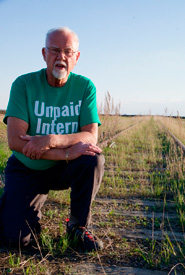Tin cans, a Mormon cricket and a UFO landing pad: One perspective on the Conservation Volunteers weekend at Old Man on His Back
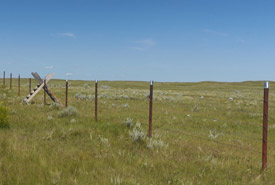
Tin cans capping fence posts (Photo by Bill Armstrong)
I understand there are likely to be a couple more Land Line blogs about the recent Conservation Volunteers (CV) weekend at the (inhale) Old Man On His Back Prairie Heritage and Conservation Area (OMB) (exhale), so let me give you my take on the place and the weekend.
The OMB site is a 13,088-acre (5,297-hectare) expanse of native grassland in southwestern Saskatchewan. Part of the land is leased for cattle grazing, while a genetically pure bison herd introduced and managed by the Nature Conservancy of Canada (NCC) roams over most of the property. And, in 2015 the Royal Astronomical Society of Canada named OMB a nocturnal preserve because, well, there are not a lot of porch lights in this part of the world.
While I can vouch for the fact that you can see stars – galaxies even – at OMB, I did not participate in the stargazing and astrophotography that took place during the weekend. I’m an early morning guy, so I left the late night/wee-hour observations to others.
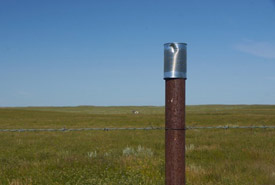
A close-up of the tin cans we used to cap fence posts (Photo by Bill Armstrong)
I did discover, though, that I’m good at scrunching empty tin cans to make them fit over fence posts. You see, in the past NCC received donations of steel pipe. Cut to the right length, they make sturdy fence posts, However, as the fence posts are hollow, small birds could fall inside them, unable to get out.
Two years ago I was part of a group of volunteers that capped a length of fencing with donated rubber caps, but there were way more posts to cap. So, NCC put out a call for people to donate tin cans, and they responded with bags filled with them. Squeezing the open end of the cans makes for a tight fit, so the cans will stay in place in the strong winds that sometimes blow through here. At least, that’s the theory. I hope to be back next year to see how we did.
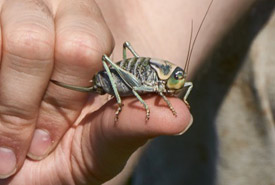
Mormon cricket (Photo by Bill Armstrong)
Capping completed, we set to work on a bioblitz of a section of land north of the OMB interpretive centre, where the bison sometimes graze. A bioblitz involves observing and recording natural features and species, and signs of human activity. Working with NCC intern Amy Russell and fellow volunteers Pat Smith and Alex Hibberd, we recorded a Mormon cricket in our observations.
Last year a group of us had seen one of these in thick grass, but it hurried away quickly, and no one was too eager to track it down. This critter was more cooperative. After Alex scooped it up, it posed like a runway model while Pat, Amy and I filled up our camera memory cards.
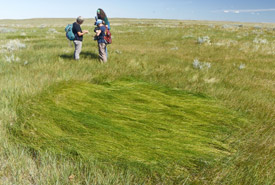
Flattened grasses in a circular pattern (Photo by Bill Armstrong)
We also came across a circle of thick grass that is noticeably different from anything around it. There may be a natural explanation, but until I hear a better one, my theory is that this is where the UFOs land while all the astronomers are looking in another direction. Why there? Well, I’m working on a research grant application right now (I jest, of course).
So, we completed some useful conservation activities, learned a bit more about the natural world while enjoying being outdoors, and all before lunch! It’s why I keep coming back each year for the CV weekend at OMB.

